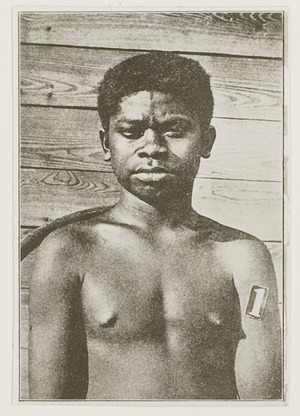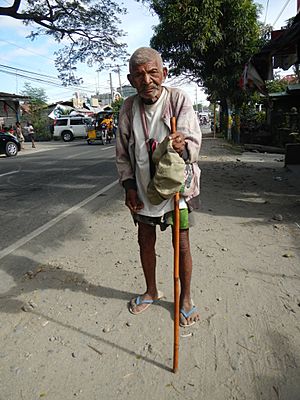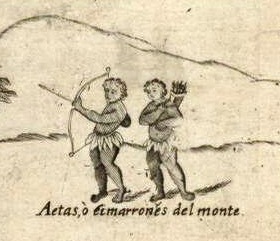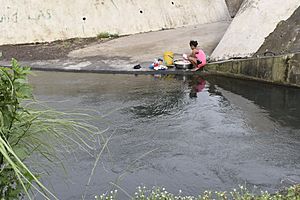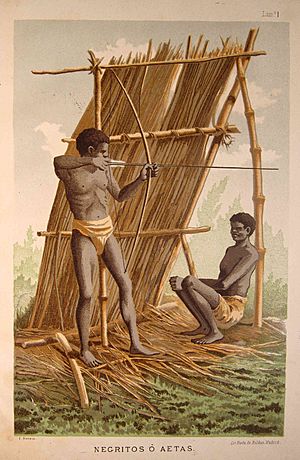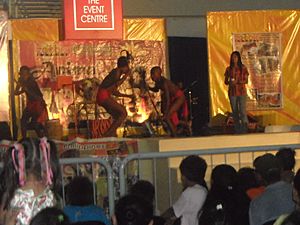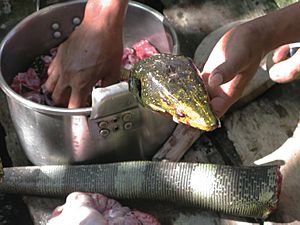Aeta people facts for kids
|
|
|---|---|
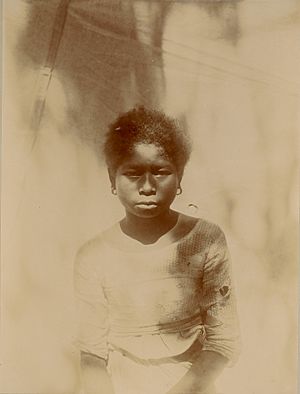
Young Aeta girl from Mariveles, Bataan, in 1901
|
|
| Total population | |
| 50,236 | |
| Regions with significant populations | |
| Languages | |
| Philippine Negrito languages, Filipino language, other languages of the Philippines | |
| Religion | |
| Christianity, Anito, folk religions | |
| Related ethnic groups | |
| Batak, Manobo, Mamanwa; other Negrito peoples |
The Aeta (pronounced EYE-tuh), also known as Agta or Dumagat, are groups of native people living in different parts of Luzon, the largest island in the Philippines. They are part of the Negrito ethnic groups. They have dark skin, are usually short, and have curly hair. Some Aeta also have naturally lighter hair.
Many people believe the Aeta were among the first people to live in the Philippines. They were here before other groups arrived from other parts of Asia. Today, Aeta communities have mixed with these other groups and speak their languages.
Historically, Aeta communities were hunter-gatherers. This means they hunted animals and gathered plants for food. They often moved from place to place in small groups, usually 1 to 5 families. The different Aeta groups are often named after where they live or the language they speak.
Contents
- What Does the Name "Aeta" Mean?
- Who Are the Aeta?
- A Brief History of the Aeta
- How Many Aeta People Are There?
- Where Do the Aeta Live?
- Aeta Way of Life
- Aeta Languages
- Aeta Beliefs
- What Do Aeta Wear?
- Aeta Skills and Practices
- Traditional Medicine
- Aeta Art
- Aeta Music
- Traditional Community Leadership
- See Also
- Images for kids
What Does the Name "Aeta" Mean?
The name "Aeta" comes from an old word, *ʔa(R)ta, which meant "person" in their ancient language. This word was later used by other groups to mean "dark-skinned person" when they arrived in the Philippines. Some people mistakenly think "Aeta" comes from the word for "black," but this is not true.
The name "Dumagat" means "people from the Magat River." It is sometimes confused with a similar word from the Visayas region, which means "sea people."
Other names for the Aeta can be unkind. For example, baluga means "half-breed," and pugot means "head-hunter." The Aeta also have names for people who are not Aeta, like putî or pute meaning "white," or unat meaning "straight-haired."
Who Are the Aeta?
"Aeta" is a general term for several different groups. While they share similar ways of life and physical features, they are not all one single group. They are often divided into three main types:
- The Aeta from Central Luzon.
- The Agta from Southeastern Luzon.
- The Dumagat from Eastern Luzon.
These names can sometimes be used for each other. The Aeta are also sometimes confused with the Ati people who live in the Visayas islands.
Here are some of the Aeta groups and where they live:
- Aeta – Central Luzon, including Zambales, Bataan, Tarlac, and Pampanga.
- Agta – Southeastern Luzon, found in Quezon, Camarines Sur, and Camarines Norte.
- Dumagat – Eastern Luzon, living in Aurora, Quezon, Nueva Ecija, Quirino, Cagayan, Isabela, and Rizal.
A Brief History of the Aeta
The Aeta, along with other Negrito groups, are believed to be descendants of the first modern humans who came to the Philippine islands. This happened about 40,000 years ago during the Paleolithic Age. They likely arrived by walking across land bridges that connected the islands to mainland Asia. Later, other groups, called Austronesian peoples, arrived by boat around 5,000 years ago.
Even though the Aeta were here first, they have mixed with the Austronesian people over time. This means many Aeta today have some Austronesian family history. They also speak Austronesian languages and have adopted some of their customs. Other Filipino groups, who are not traditionally called Negritos, also have some Negrito family history.
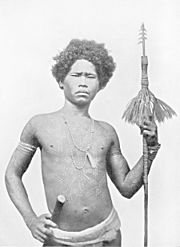
A recent study in 2021 found something interesting about the Aeta. The Ayta Magbukon group, in particular, has the highest level of Denisovan ancestry in the world. Denisovans were an ancient group of humans. This suggests that a special group of Denisovans lived in the Philippines and mixed with modern humans when they arrived.
Unlike many other Filipino groups, the Aeta have tried to keep their traditional ways. They had little contact with the Spanish rulers who came to the Philippines. The Spanish tried to make them live in special settlements, but the Aeta usually stayed in the mountains.
Old Spanish records show that the Negritos used iron tools and weapons. They were known for being very good with a bow and arrow and were brave fighters. However, because there were fewer of them and they lived in small groups, they were sometimes taken advantage of by larger, more organized groups.
How Many Aeta People Are There?
In 2010, there were about 50,236 Aeta people living in the Philippines.
Where Do the Aeta Live?
Aeta communities are found in Zambales, Tarlac, Pampanga, Panay, Bataan, and Nueva Ecija. After the huge Mount Pinatubo eruption in 1991, many Aeta had to move to new homes in Pampanga and Tarlac.
Some Aeta communities have received special government papers called "Certificate of Ancestral Domain Title" (CADT). These papers officially recognize their claims to their traditional lands. For example, in 2009, 454 Aeta families in Pampanga received a CADT for about 7,440 hectares of land. In 2010, 1,501 Aeta families in Zambales received a CADT for 15,860 hectares.
Even with these efforts, some Aeta communities still find it hard to get titles for their ancestral lands.
Aeta Way of Life
The Aeta are often nomadic, meaning they move around. They build simple shelters from sticks and banana leaves. Some Aeta have moved to villages and live in houses made of bamboo and grass.
Sadly, things like mining, cutting down forests, and illegal logging have caused the number of Aeta people to shrink. The Philippine government offers little protection, and the Aeta often have to move because their traditional way of life is changing.
As hunter-gatherers, the Aeta are very good at adapting to their environment. They know a lot about the tropical forests, typhoon seasons, and other weather changes. This knowledge helps them find food and survive. Storytelling is also very important. Like many hunter-gatherer groups, the Aeta use stories to teach important values like cooperation. Good storytellers are highly respected.
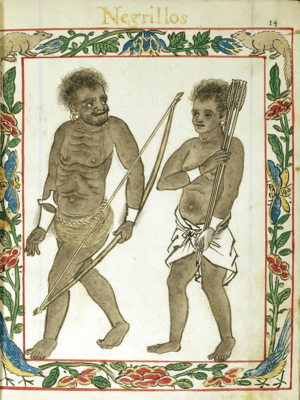
The dry season is a busy time for many Aeta. They hunt and fish more. They also prepare land for farming using a method called slash-and-burn. Both men and women clear the land, but women usually do most of the harvesting. During this time, they also trade with non-Aeta communities or work as farmers. Aeta women are very active in trading and working in agriculture. While the dry season brings plenty of food, the rainy season can be difficult because it's harder to hunt and gather in wet forests.
Aeta communities use different tools for hunting and gathering. These include traps, knives, and bows and arrows with special tips for different uses. Most Aeta, including women, learn to hunt and gather by age 15. While men and some women use bows and arrows, most Aeta women prefer knives and often hunt in groups with their dogs. Both men and women also fish and gather food. This shows that Aeta communities are quite equal in how men and women share tasks.
Aeta Languages
All Aeta groups have adopted the languages of their Filipino neighbors. Over time, these languages have changed and become unique Aeta languages. Some of these include Mag-indi, Mag-antsi, Abellen, Ambala, and Mariveleño.
Aeta Beliefs
The Aeta have different spiritual beliefs. Some believe in one supreme being who rules over other spirits. For example, the Aeta of Mount Pinatubo worship "Apo Na."
The Aeta are also animists. This means they believe that spirits live in nature. They think good and evil spirits live in rivers, the sea, mountains, and other places. They believe a forest spirit named Kamana appears to give comfort and hope during hard times.
The Aeta pray at any time, but their prayers are often connected to their daily activities. They dance before and after hunting pigs. Before women gather shellfish, they perform a dance to apologize to the fish and to ensure a good catch. Men also do a bee dance before and after looking for honey.
Some Aeta believe in four forms of a "great creator" who rules the world:
- Tigbalog is the source of life.
- Lueve helps with growth.
- Amas brings feelings of pity, love, and peace.
- Binangewan is responsible for change, sickness, and death.
They also believe in specific gods:
- Gutugutumakkan – The main creator.
- Kedes – The god of hunting.
- Pawi – The god of the forest.
- Sedsed – The god of the sea.
Christianity Among the Aeta
In the 1960s, Christian missionaries came to the Aeta. They offered education and taught some Aeta to become pastors. Today, many Aeta in Zambales and Pampanga are Christians, especially Evangelicals. Some Aeta are also Jehovah's Witnesses.
What Do Aeta Wear?
Their traditional clothes are very simple. Young women wear wrap-around skirts. Older women wear clothes made from tree bark, and older men wear loincloths. Today, many Aeta who have met people from the lowlands wear T-shirts, pants, and rubber sandals, just like others.
Aeta Skills and Practices
The Aeta are skilled in weaving and plaiting (braiding). Women are the only ones who weave winnows (flat baskets for separating grain) and mats. Only men make armlets. They also create raincoats from palm leaves that spread out like a fan around the body.
Studies show that about 85% of Aeta women hunt, and they hunt the same animals as men. Aeta women often hunt in groups with dogs and are quite successful. They are even more successful when they hunt with men.
Traditional Medicine
Aeta women are known for their knowledge of herbal medicines.
For example, in one Aeta community, they use banana leaves for toothaches. They also bathe in water boiled with camphor leaves to help with fever, or they drink herbal teas made from these leaves. For muscle pains, they drink tea from kalulong leaves. After giving birth, women bathe in water boiled with sahagubit roots to prevent illness. This root tea is also used to help children with worms or stomachaches. They also use wormwood leaves for women's irregular periods and lemon grass for blood pressure.
If herbal medicines don't work, the Aeta might seek help from an herbolario (a traditional healer). They believe that some illnesses are caused by spirits they might have upset. In such cases, the herbolario performs a ritual to make the spirits happy again.
The Aeta are proud of their traditional medicines and natural ways of healing. They find their medicines in nature, which helps them save money and respect their environment.
Aeta Art
One traditional art form is body scarification. The Aeta intentionally make small wounds on their skin, then irritate them with fire or lime to create raised scars. These scars can be found on their backs, arms, chests, legs, hands, and stomachs.
Another practice is chipping their teeth. Young Aeta people might file their teeth to change their shape, and then dye them black a few years later.
The Aeta also wear simple ornaments. They use flowers and leaves as earplugs for special events. They often wear belts, necklaces, and neckbands made of braided rattan with wild pig bristles.
Aeta Music
The Aeta have a rich musical heritage. They use different types of agung ensembles. These are groups of large hanging or held gongs that create a deep, humming sound without other instruments playing melodies.
Traditional Community Leadership
Traditionally, Aeta communities did not have official chiefs or leaders who told everyone what to do. Everyone was considered equal. Their traditions guided their social interactions. Elders, called pisen, would help make decisions, but their advice was not forced on anyone. They solved problems by talking things through until everyone understood.
Over time, as Aeta communities had more contact with other Filipino groups, their traditional leadership changed. Sometimes, they were encouraged to create government-like systems with a "Captain" or "Council." However, they often resisted these changes. They usually do not appoint a single chief. When someone does something wrong, they discuss it to understand why it happened and prevent future problems, rather than focusing on punishment. Young people are usually not part of these discussions. While women can attend hearings and share their opinions, they are often not part of the main decision-making process, as their main role is often seen as caring for children and husbands.
See Also
 In Spanish: Aeta para niños
In Spanish: Aeta para niños
- Buno
- Semang
Images for kids


